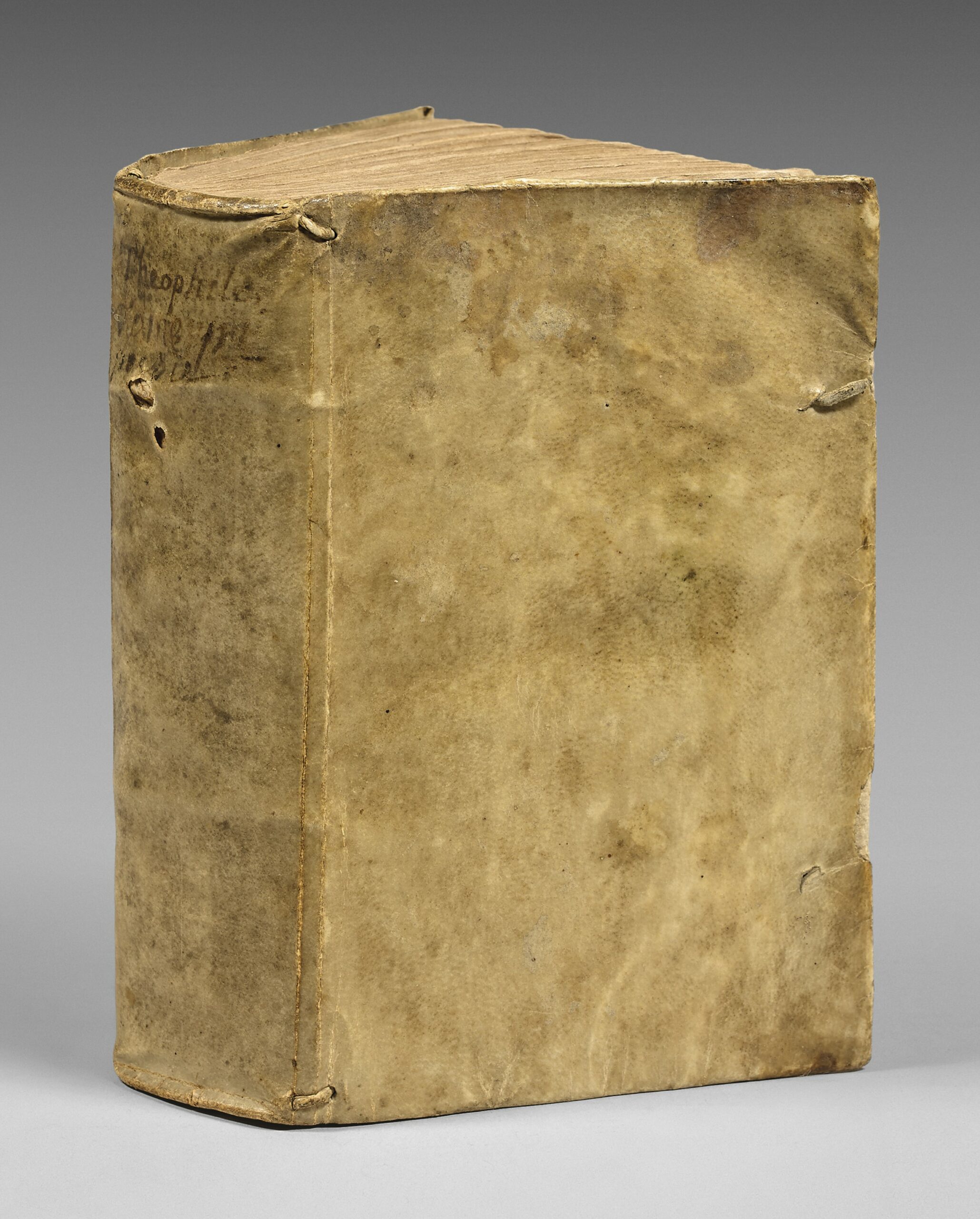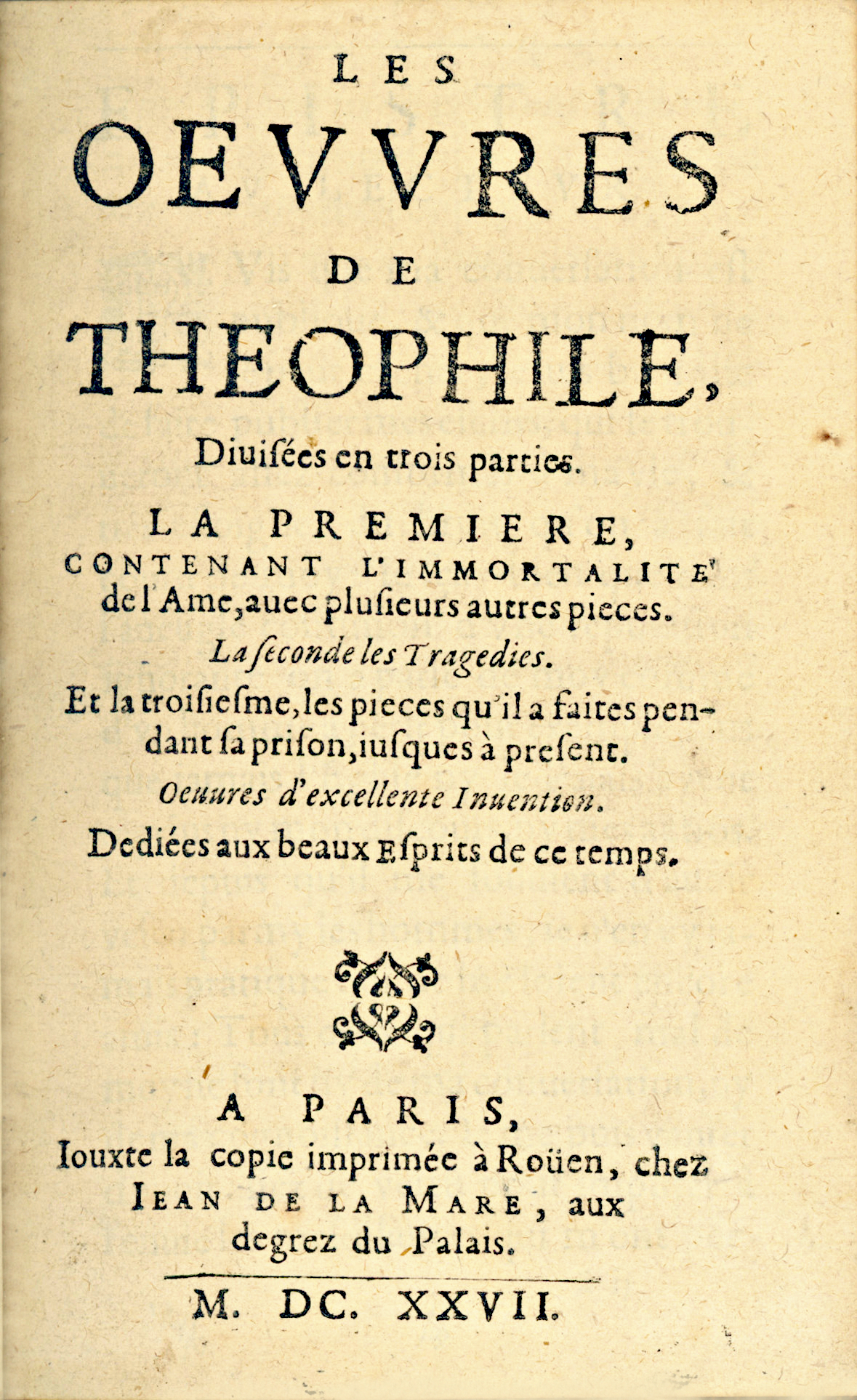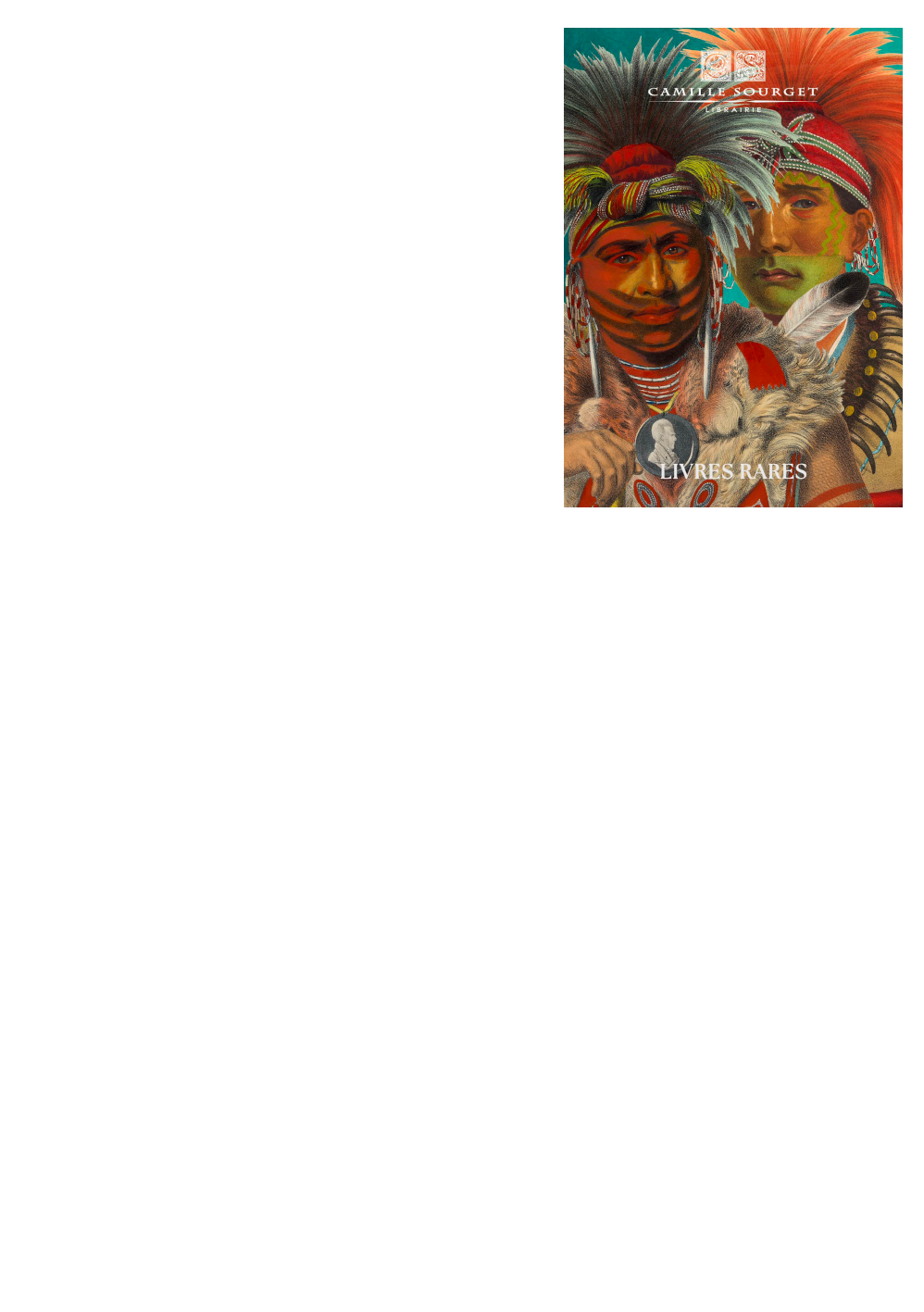A Paris, Iouxte la Copie imprimée à Rouen, chez Jean de la Mare, 1627.
– Followed by : Œuvres du Sieur Theophile. Seconde partie. 1628.
– Followed by : Recueil de toutes les pièces que le Sieur Théophile a mises en lumiere pendant sa prison, iusques à present. Avec quelques autres Œuvres à luy envoyees par ses Amis. Troisieme partie. 1628.
– Followed by : Apologie de Theophile au Roy.
A total of 4 parts in 1 volume 8vo of (8) ll., 336 pp., 160 pp., (1) l. of title, pp. 163 to 285, 69 pp.
Full limp vellum, flat spine, remains of ties. Contemporary binding.
165 x 103 mm.
Very rare collective edition partially original of the Works of Theophile de Viau (1590-1626) gathering together the three parts that had been published separately, namely the first part, Paris, J. Quesnel, 1621, 8vo; the second, Paris, Quesnel and Billaine, 1623; the third in 1624, the volume ends with a separate part of 69 pp.: “L’Apologie de Theophile au Roy”.
Our edition is so rare that it remained unknown to most bibliographers. Tchemerzine cites another edition from 1627 according to the Solar catalog, and G. Saba, Théophile de Viau, 2007, n°50, lists only 4 other copies: Arsenal, Orléans, Yale, and Toronto.
The first collective edition of the Works of Théophile de Viau was printed in Paris by Billaine, the year before, in 1626. It is, of course, unfindable, and Tchemerzine does not know it.
“It is extremely rare; Father Niceron seems to have seen it, but Abbot Goujet only knew the 1627 edition and one from 1643, which he called the Second, and finally an in-12 edition from 1662. Lachèvre, whose documentation is immense, says he has not seen it. We do not know it.” (Tchemerzine, V, p. 860).
According to Abbot Goujet (Volume XIV, p. 496), the first collective edition would be identical to ours, printed in Rouen, by Jean de la Mare, in 1627. It is so rare that Tchemerzine mentions “we do not know it.”
In fact, the collective editions from 1626-1627 are so rare – Théophile, who died in 1626, had just endured a terrible trial, and his works were condemned and burned – that they are today either unknown, as is the case with the one presented here, or listed in only a few rare copies worldwide.
The only other copy printed in Paris in 1627 cited by Tchemerzine (V, p. 863): “the Paris edition, 1627, is cited in the Solar catalog, n°1311” is actually another edition composed differently, ending with the Tragédie de Pasiphae. The first collective edition with continuous pagination was only published two years later, in 1629, by the same printer. A Paris, Iouxte la Copie imprimée à Rouen, chez Jean de la Mare, aux degrez du Palais, 1629.
The place of Théophile is essential in French literature. According to Ant. Adam, he “renewed French poetry,” he is “the first of our great classical prose writers.” Living in the libertine milieu, he clashed with the Jesuits who made every effort to have him condemned. His paraphrase of Phaedo under the title “ Traicté de l’immortalité de l’âme ” led to his classification among the followers of Giordano Bruno and Vanini, and the boldness of his licentious verses blackened the image they made of him. “He only knew the flames in the form of a straw man dressed in a satin doublet; he was nevertheless condemned, and his friends received a double lesson, first from his peril, and then from his anguish...” (R. Pintard).
Théophile de Viau died at the age of 36, more worn out, wrote Henri Mondor, by his persecutors than by his libertinism. Assured, however, according to the best minds of his time, of literary immortality… (He) was one of the great French lyric poets. The brief beauty of women, their smiling betrayal, their decrepit old age… particularly inspired him… the graces of his natural tone announced La Fontaine; his bravery and freedom continued Villon. Mallarmé… Accorded to theophile de viau such an important place that it honored both him and the other.
An initial exile led the poet to the Netherlands, with Guez de Balzac. According to Henri Mondor, a quarrel, perhaps comparable in some ways to that of Verlaine and Rimbaud, separated them. Returning to France, pensioned by Louis XIII, Théophile de Viau had to flee again to England where the Duke of Buckingham welcomed him; returning in 1621, he renounced Protestantism and mingled with the poets of the cabarets of the Île Saint-Louis; accused of being the author of scandalous poems, he was arrested and incarcerated in Ravaillac’s own cell. After a long trial, he benefited from the king’s protection and was executed in effigy only.
Often reprinted, his “poetic works” would know such success in the seventeenth century that even the glory of Malherbe would pale. Symbol of an uncertain time, strong in its hesitations, which prepares the advent of classical order, but has yet sacrificed nothing to it, the art of Théophile has the virtues and limits of its preciousness. “The universe sets its horizons, consents to more “morning” or “Solitude.” The author of the “ Elégie à une dame ” narrowly misses the secret of Jean de la Fontaine; one of laziness that is availability, of idleness that is docility to the gods. Sometimes a dream, a premonition, cracks an ode, fissuring the conventional supernatural. Is the best Théophile found in the stripped prose of the letters, of the “ Apologie au roi ” of the Latin novella “Larissa,” of the “ Fragments d’une histoire comique” or in the flamboyant lyricism of his tragedies, “Pasiphae,” “Pyrame” and “Thisbe“? More musical than Racan, more robust than Tristan, the bird Théophile crosses the centuries more happily than he did his own time.” Antoine Duminaret.
His poetry will enchant Mallarme.
Deeply renewing baroque poetry through the naturalness of his lyricism and the vivacity of his imagination, the poet substitutes religious inspiration with the exaltation of nature, demonstrating an Epicurean naturalism with a decidedly materialistic tendency.
« Je veux faire des vers qui ne soient pas contraints,
Promener mon esprit par de petits desseins,
Chercher des lieux secrets où rien ne me déplaise,
Méditer à loisir, rêver tout à mon aise,… ».
With a very pronounced sensitivity, Théophile sings of solitude, passionate love, and the Beauty of nature:
… « la charrue écorche la plaine ;
Le bouvier, qui suit les sillons,
Presse de voix et d’aiguillons
Le couple de bœufs qui l’entraîne…
Une confuse violence
Trouble le calme de la nuit
Et la lumière, avec le bruit,
Dissipe l’ombre et le silence… »
The complete works of Théophile de Viau printed before 1630, bound in vellum of the time, are of the utmost rarity.
A superb copy of this precious partly original collective edition, preserved in its limp vellum of the time.



